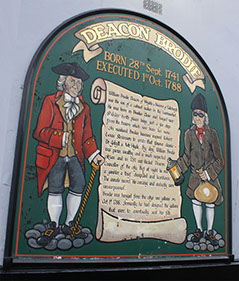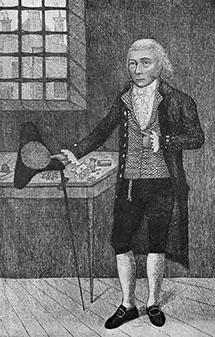
deacon brodie
The real story behind Edinburgh's most enduring legend

Deacon Brodie's Early Life
His Profession
Edinburgh’s Royal Mile hosts the Deacon Brodie Tavern that serves as a perpetual monument to the duplicitous Deacon. On one of the tavern’s side walls, we can find this soundbite version of Brodie’s life:
Deacon Brodie
Born 28th Sept. 1741
Executed 1st Oct. 1788
 William Brodie Deacon of Wrights and Masons of Edinburgh was the son of a cabinet maker in Lawnmarket. He was born in Brodie's Close and hanged near St. Giles both places being just a few steps from the tavern which now bears his name. In manhood, Brodie’s baseness inspired Robert Louis Stevenson to write that famous classic—Dr. Jekyll & Mr. Hyde. By day, William Brodie was pious, wealthy and a much respected citizen and in 1781 we elected Deacon Councilor of the city. But at night he was a gambler, a thief, dissipated, and licentious. The annals record his cunning and audacity were unsurpassed. Brodie was hanged from the city’s new gallows on Oct 1st 1788. Ironically he designed the gallows that were to eventually seed his fate.
William Brodie Deacon of Wrights and Masons of Edinburgh was the son of a cabinet maker in Lawnmarket. He was born in Brodie's Close and hanged near St. Giles both places being just a few steps from the tavern which now bears his name. In manhood, Brodie’s baseness inspired Robert Louis Stevenson to write that famous classic—Dr. Jekyll & Mr. Hyde. By day, William Brodie was pious, wealthy and a much respected citizen and in 1781 we elected Deacon Councilor of the city. But at night he was a gambler, a thief, dissipated, and licentious. The annals record his cunning and audacity were unsurpassed. Brodie was hanged from the city’s new gallows on Oct 1st 1788. Ironically he designed the gallows that were to eventually seed his fate.
A peculiar thing happens when a historical figure’s life transcends the plane of history into the realm of folklore. The commonly accepted account of the historical figure’s life—that was an existence as rife with complications outside influences, and circumstantial decision marking as yours or mine—magically transforms into a five-minute tour guide spiel. Fact and fable are distilled down into easily marketable bullet points that allow the listener to remember the tale while being shuffled off into a gift shop. This reduction of facts unfortunately exists in the strange case of Deacon Brodie.
Deacon Brodie from
Kay’s Edinburgh Portraits While the Tavern’s account is not inaccurate, it is a tad misleading on some points. Brodie’s father, Francis’, profession was more akin to an architect or general contractor than cabinetmaker—although the Brodie workshop did produce furniture. The claim that Deacon Brodie designed the gallows in which he was hung has been called into question by historians and researchers. His dissipation, licentiousness, cunning, and audacity are also somewhat overrated. While it is true Brodie was a gambler extraordinaire and had five children by two different women, his behavior is less shocking that most guests on daytime TV chat shows and was on par with Brodie’s contemporaries. William Brodie was also nowhere in the same criminal league as the headline-grabbing Cray Twins and Brodie’s crew would have been laughed out of the pub by the infamous syndicate “the Firm.”
While the Tavern’s account is not inaccurate, it is a tad misleading on some points. Brodie’s father, Francis’, profession was more akin to an architect or general contractor than cabinetmaker—although the Brodie workshop did produce furniture. The claim that Deacon Brodie designed the gallows in which he was hung has been called into question by historians and researchers. His dissipation, licentiousness, cunning, and audacity are also somewhat overrated. While it is true Brodie was a gambler extraordinaire and had five children by two different women, his behavior is less shocking that most guests on daytime TV chat shows and was on par with Brodie’s contemporaries. William Brodie was also nowhere in the same criminal league as the headline-grabbing Cray Twins and Brodie’s crew would have been laughed out of the pub by the infamous syndicate “the Firm.”
William Brodie was a sub-par burglar whose successes were more luck than skill. The firsthand accounts that survive of Brodie's larceny show a man who was a thoughtful planner who was horrid at execution. All of Brodie’s crimes culminated in ripping off Edinburgh’s Excise office for an approximate take of £16 split between his three other accomplices. Brodie almost escaped justice having fled Edinburgh for Amsterdam via Ostend shortly after the Excise Office robbery. Our good Deacon’s luck ran out, and he was captured the night before boarding a ship bound for America.
The unanswered question of Deacon Brodie’s life is, “why?” What drives a man who has risen to the pinnacle allowed his station in 18th century society to become a common burglar? An examination of what is know of his early life may yield some clues. In the parlance of the time, William Brodie came from “good stock” as William Roughead attests in The Trial of Deacon Brodie:
His great-grandfather, Francis Brodie of Milnton, Elginshire, was a member of a family well known in the North of Scotland, and his grandfather, Ludovick Brodie of Whytfield, was a much respected Writer to the Signet in Edinburgh, who, on his death in 1758, was the oldest member of the Society. His father, Francis Brodie, was born in 1708, and in 1740 married Cecil, daughter of William Grant, writer in Edinburgh, with whose family he was already connected. Both the Deacon's grandfathers, therefore, were members of the legal profession. [Later in the text] Francis Brodie was a substantial wright and cabinetmaker in the Lawnmarket of Edinburgh, where he carried on an extensive and prosperous business. In 1735 he was made a Burgess, and in 1763, a Guild Brother of his native burgh. That he stood high in the estimation of his fellow-craftsmen is evidenced by his being, in 1775 and 1776, elected a member of the Town Council as Deacon of the Incorporation of Wrights, and again in 1779 and 1780, in the same capacity; while in 1776 he also represented the Incorporated Trades of the city as their Deacon Convener.
What’s not said in this write-up of William Brodie’s pedigree is what’s of most interest. Why Francis Brodie did not follow in his father’s footsteps in the legal profession is unknown. We often see in modern accounts that William Brodie and his father were cabinet makers. It is likely that saddling William Brodie’s profession as only a cabinet maker came from Robert Louis Stevenson’s tale that his grandfather purchased a chest of drawers made by William. Also, court documents do refer to William Brodie’s profession as “sometimes wright and cabinet maker.” While cabinet making was a portion of the Brodie family business, to think of the father/son team as simply cabinet makers is misleading.
Francis and William were wrights, and even that term has a broader meaning in 18th century Scotland than it should. The word we use as “wright” derives from the Old English word wryhta or wyrhta which was something of a catchall word for craftsman, worker, or simply someone who build or creates something. The Old English word morphed into the Modern English wright, but the nebulous definition remained. In the 18th century, the type of wrights William and Francis Brodie consisted of being part carpenter, surveyor, drafter, architect, and structural engineer all rolled into one. Francis also aspired to work as an architect and even used an image of the extraordinarily influential Venetian architect Andrea Palladio as the sign for the Brodie business. Period Guild Court documents have also shown examples of both Francis and William drawing up architectural plans and listing themselves as “architect.” The goal here is not to denigrate the profession of cabinet maker or any other derivation of wrights in the 18th century. The objective of this discussion is to illustrate the breadth of knowledge William had gained as a “wright” would be a significant advantage in his secondary career.
The line of particular categorization within a trade are further blurred to in our modern minds because of Edinburgh’s guild system. In total, there were 14 different trade incorporations, or guilds, active in Edinburgh during William’s life. Francis and William belonged to the Incorporation of Wrights and Masons and that allowed them to work on any job that was under the purview of their incorporation. The flexibility to working within all aspects of guild approved work freed the Brodies’ business on the dependency of larger construction jobs as a single source of income. It is likely that Francis and William employed a number of different specializations of wrights in their workshop to maximize their profit potential. At one point, Francis even tried to exploit the undertaker market in 1773. The Brodies were probably constructing caskets in their workshop and decided to see if undertaking would be suitable sideline. The venture was likely not what the Francis and William expected, and the undertaker’s shingle was taken down by the summer of 1775.
Possibly the crowning achievement of both Francis and Williams’ professional careers was being selected as Deacon of the Incorporation of Wrights and Masons. The post held by both Brodies sounds like no more than a glorified union boss, but the guild system in 18th century Edinburgh lay at the heart of the city’s governance. Another testament to the skills of both Francis and William was their inclusion on the Council of Edinburgh’s Dean of Guild Court. (Francis was a council member of the Council 1776 and 1780. William’s membership included the years 1782-4 and 1786-7. ) According John Stark's 1806 book, Picture of Edinburgh, the Guild Court was:
...composed of an officer, called the Dean of Guild, assisted by a council of four members, appointed by the Magistrates. It takes cognizance of all the buildings which are erected within the city and liberties, none of which can be built without a warrant from this court. It has also the privilege of visiting and inspecting such houses as are insufficient, or in danger of falling down, and has a power of condemning them, if found insecure, and of obliging the proprietors to pull them down and rebuild them. The Dean of Guild Court inspects and regulates all the weights and measures used in the city; and has a power of seizing such as are found deficient, and punishing the persons who use them by fine and confiscation. This court likewise takes account of all the merchants and tradesmen within the town; and sees that none exercise these professions except those who have been admitted to the freedom of the city.
Aside from any political connections that would have been required to secure a seat at the council, technical skills would be needed to judge the matters appearing before the court. The vast majority of councils from 1770-1800 were made up of two merchants, with the other three seats being filled by wrights, masons, glaziers, and painters. By weighing the council with members having technical knowledge one can easily deduce their expertise was desired. There was another perk of being part of the Dean of Guild Court, council members got first crack at petitioner’s projects.
Brief History of Deacon Brodie at Edinburgh's Deacon Brodie Tavern on the Royal Mile
We’ve attempted to present as many source documents on the Deacon Brodie website as possible. This includes public domain books and searchable book previews of Brodie related books; letters and documents by Deacon Brodie; an interactive timeline that frames the events of Deacon Brodie’s life with world events; people who touch on Deacon Brodie’s story; and articles (coming soon) about 18th century life, research techniques, and interpretations about Brodie’s life. These resources are not only valuable for those interested in discovering the real story of Deacon Brodie, but 18th-century armchair historians, Scotland enthusiasts, and genealogists. Click on the links in this paragraph or on the sliding menu above to find out items that interest you the most.
Contact us
Notices
